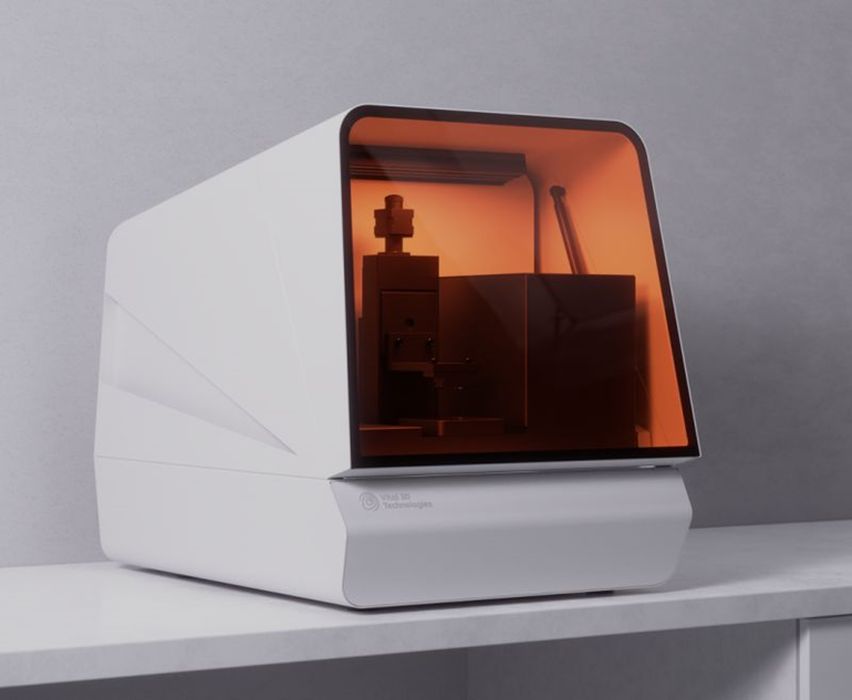
Charles R. Goulding and Andressa Bonafe sit down for a chat with Vidmantas Šakalys, co-founder and CEO of Vital3D Technologies.
Our series of interviews with 3D printing experts has so far covered innovative work with glass, metals, construction, and surgical planning. We have also started to explore an international perspective on 3D bioprinting, in a fascinating conversation with Bruna Alice Gomes de Melo, a Brazilian researcher who was involved in the creation of a protocol for 3D printing brain cells. Today, we continue our global investigation with an interview with Vital3D CEO Vidmantas Šakalys. Located in Lithuania, Vital3D Technologies is a provider of laser-based 3D bioprinting solutions. Its innovative technology uses lasers to precisely deposit living cells and biomaterials in 3D patterns with the goal of creating functional, scalable, and reproducible tissue constructs.

We are curious to know more about Vital 3D. Could you give us an overview of the company and its mission?
Vital 3D is a young company, it was created two years ago. Currently, we have 10 people on board working with us. There are three co-founders: Dr. Linas Jonušauskas, who specializes in laser technologies; myself, with more of a computer engineering background; and Prof. Dr. Paulius Pakutinskas, who focuses on the legal and patent-related aspects.
Our initial idea came from Dr. Linas Jonušauskas and his wish to develop some kind of fast, laser-based 3D printing. When I questioned him about the potential applications of this printer, we began to discuss bioprinting and how the green light of a laser is considered safe as cells are transparent through green light. We then started thinking about printing kidneys. Personally, I had a former colleague who died from renal infections and cancer so I was particularly drawn to this challenge.
This is how Vital 3D was born. Our mission is to develop 3D bioprinting technology to eventually print full-scale human organs. Our goal is to start with kidneys because there is a very high demand for transplants. In the United States alone, there are over 100,000 people waiting for different organs, and about 90,000 of those are kidneys. Sadly, only around 20,000 donors become available each year.
We are based in Lithuania, where there is a very strong community of laser science and research. We can build on this knowledge that is around us. We work with scientists from different backgrounds and have partnerships with multiple research and academic institutions, such as the Lithuanian Cancer Institute, the Lithuanian Health Sciences University, and the Business University. Currently, we are also engaging in international collaboration, with interesting projects in partnership with the Utrecht University, University of Twente, Universitair Medisch Centrum Utrecht in the Netherlands and university of Wuerzburg from Germany.
What is the FemtoBrush technology? How does it work? What are some of its advantages for 3D bioprinting?
Laser-based bioprinting technology is not new. Actually, many companies are developing different laser-based printers. However, despite being a very precise instrument, laser tends to be slow because it prints on a point-by-point basis. In layman’s terms, we can compare it to a pencil. If I gave you a pencil and asked you to paint the wall behind you, it would take a lot of time. Our proprietary technology allows users to dynamically change the beam size from a pencil all the way to a painting roller, so to speak. You could use a roller to paint the wall, which would be so much faster, and then switch to a pencil to draw a small flower with great detail. In simple terms, by dynamically changing the beam size, we can speed up laser-based bioprinting, getting very precise, down to one micron printing, but at the same ensuring efficiency.
This technology can be particularly helpful in overcoming the challenge of printing small vascular networks. In large organs, these networks are crucial to maintaining healthy cells, as they are responsible for bringing oxygen and nutrition inside big tissues. In order to successfully 3D bioprint full-scale human organs, we need great lengths of capillary networks that are very small in size, around 3-5 microns in diameter – going back to our analogy, we need to paint them with a pencil. At the same time, the whole organ in itself is quite big, so we need to use a painting roller for efficiency. Our patented technology is intended to help overcome this challenge.
I understand that your ultimate goal is to 3D bioprint kidneys. Until you achieve that, however, I imagine you must be working on other applications. Can you tell us more about the current work of Vital 3D?
You are right, it’s a very long journey until we get to print full-scale human organs. For now, we are working on biocompatible scaffolds that can be used in tissue engineering to create organoids. These structures allow oxygen and nutrition to reach the inner cells of organoids so that they can survive. Scaffolds are particularly important for drug testing, with the final goal of eliminating animal testing in drug development. Currently, we print scaffolds that are used by various labs that do specialized research on various diseases. This technology allows pharmaceutical testing to be much faster and more efficient.
Another application of our technology is the creation of lab-on-chip systems, in which we print the organoid and specific cell cultures inside the microfluidic device. Currently, we are developing nephron-on-a-chip, which could be characterized as the early stages of creating kidneys. The nephron is the basic structural and functional unit of the kidney, where the blood filtration process takes place. So with nephron-on-a-chip we can actually test drugs for different kidney diseases.
And the third application that we are exploring is stents and grafts. Many printed stents and grafts are currently made from metal, which is recognized as alien material by the body and can potentially cause complications. By printing from bio-polymers, we can avoid these problems.
We are also investigating the use of grafts as the basis for vascular networks. This effort could eventually allow us to print a graft from the cells and the polymer and use it to replace the faulty part of a vascular network through surgical implantation. We are testing different types of grafts and discussing with partners at different universities to figure out which could be most useful.
In this kind of research, what are some of the tests you perform to assess the quality of the 3D bioprinted product?
There are two types of tests. First, mechanical tests, because the stents and grafts should be able to contain very high pressure. Second, we look at the compatibility, meaning that we implant these stents and grafts into animals and observe their reaction. We are still in the initial stages, but we have very promising indications in both types of tests.
Focusing now on the bigger picture, what do you see as the main challenges and opportunities for the future of 3D bioprinting?
There are still a lot of technological challenges in bioprinting. That’s why the market at the moment is very fragmented. There are different academic groups and startups that are working on it from different angles and approaches but there is no single player that stands out. We are all developing the market and trying to solve different challenges.
One of these challenges, which I already mentioned, is the ability to print vascular networks in a viable time. Another challenge is how to control cell growth. Specifically, how to get different cells to grow and how to print them in one organ. For example, the kidney has about 20 different types of cells. So it’s a challenge because you need to print from different types of cells and then be able to control how they grow to get the kidney.
Despite these challenges, most of the scientists in this area agree that bioprinting is doable and it is just a matter of time. They agree that in about 20 years or so it’s feasible to conceive our first bioprinted large organ. That means that the market is evolving at a steady pace. And it’s just a matter of time for us to see organs transplanted first in animals and then humans.
Currently, what has been actually achieved is skin printing in large quantities for cosmetics testing and treatment of burned areas. Because the skin is so flat, we can feed it from both sides and we don’t rely on the vascular network as much for keeping cells alive.
Personally, I believe that there will be a breakthrough at some point in around 5 years, someone will start building large organs and then everyone will follow. There are a lot of opportunities for this, not only just transplants but there are different applications as well, such as treating diseases and eliminating animals from the drug development cycle. Overall, it is really impressive what we can achieve.
Going back to Vital 3D, what are some of your expectations for the near future?
We will be looking for series A investment this year. We see the need for investment in the development of certified products. Certification is very important and it takes time. At the moment we are working on non-certified micro medical devices but we plan to start implementing certification on these products. Because our target markets are both the United States and Europe, we will pursue international certification.
Conclusion
Though still in its relatively early stages, laser-based 3D bioprinting technology has great potential for a myriad of applications, from drug development to the creation of transplantable organs. Companies like Vital3D must undergo intensive testing and face considerable regulatory challenges designed to ensure the safety and functionality of their technology. We are excited to see what the future holds for this inspiring Lithuanian startup.
